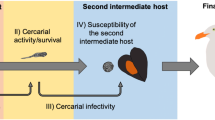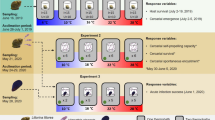Abstract
With the prospect of large-scale environmental changes, there is an urgent need to obtain information regarding environmental influences acting on the emergence of cercariae in marine systems. We investigated the response of trematodes of the intertidal snail Zeacumantus subcarinatus to altered temperature, salinity, and water level. The emergence of one trematode species, Maritrema novaezealandensis (Microphallidae), showed a weak trend to decrease with increased temperature; whereas, the emergence of a second species, Philophthalmus sp. (Philophthalmidae), increased at warmer temperatures. Both species exhibited increased cercarial emergence at the lowest salinity used (30 PSU). More M. novaezealandensis cercariae emerged when snails were kept partially submerged. In contrast, emergence of Philophthalmus sp. increased when snails were completely submerged. These results may reflect different transmission strategies employed by the two trematode species. Based on this model, we propose that trematode parasitism in intertidal zones is likely to be impacted by various changes in the marine environment resulting from global warming.




Similar content being viewed by others
References
Berger VJ, Kharazova AD (1997) Mechanisms of salinity adaptations in marine mollusks. Hydrobiologia 355:115–126
Cheng RT, Casulli V, Gartner JW (1993) Tidal, residual, intertidal mudflat model and its applications in San Francisco Bay, California. Estuar Coast Shelf Sci 36:235–280
Combes C, Fournier A, Mone H, Theron A (1994) Behaviours in trematode cercariae that enhance parasite transmission: patterns and processes. Parasitology 109:S3–S13
Fingerut JT, Zimmer CA, Zimmer RK (2003) Patterns and processes of larval emergence in an estuarine parasite system. Biol Bull 205:110–120
Fredensborg BL, Mouritsen KN, Poulin R (2005) Impact of trematodes on host survival and population density in the intertidal gastropod Zeacumantus subcarinatus. Mar Ecol Prog Ser 290:109–117
Knauss JA (1978) Introduction to physical oceanography. Prentice Hall, New Jersey
Koprivnikar J, Poulin R (2009) Interspecific and intraspecific variation in cercariae release. J Parasitol 95:14–19
Lo C-T, Lee K-M (1996) Pattern of emergence and the effects of temperature and light on the emergence and survival of heterophyid cercariae (Centrocestus formosanus and Haplorchis pumilio). J Parasitol 82:347–350
Lyholt HCK, Buchmann K (1996) Diplostomum spathaceum: effects of temperature and light on cercarial shedding and infection of rainbow trout. Dis Aquat Org 25:169–173
Marcogliese DJ (2001) Implications of climate change for parasitism of animals in the aquatic environment. Can J Zool 79:1331–1352
Martorelli SR, Fredensborg BL, Mouritsen KN, Poulin R (2004) Description and proposed life cycle of Maritrema novaezealandensis n. sp. (Microphallidae) parasitic in red-billed gulls, Larus novaehollandiae scopulinus, from Otago Harbour, South Island, New Zealand. J Parasitol 90:272–277
Martorelli SR, Fredensborg BL, Leung TLF, Poulin R (2008) Four trematode cercariae from the New Zealand intertidal snail Zeacumantus subcarinatus (Batillariidae). N Z J Zool 35:73–84
Mouritsen KN (2002a) The Hydrobia ulvae–Maritrema subdolum association: influence of temperature, salinity, light, water-pressure and secondary host exudates on cercarial emergence and longevity. J Helminthol 76:341–347
Mouritsen KN (2002b) The Hydrobia ulvae–Maritrema subdolum association: cercarial emergence controlled by host activity. J Helminthol 76:349–353
Mouritsen KN, Jensen KT (1997) Parasite transmission between soft-bottom invertebrates: temperature mediated infection rates and mortality in Corophium volutator. Mar Ecol Prog Ser 151:123–134
Mouritsen KN, Tompkins DM, Poulin R (2005) Climate warming may cause a parasite-induced collapse in coastal amphipod populations. Oecologia 146:476–483
Poulin R (2006) Global warming and temperature-mediated increases in cercarial emergence in trematode parasites. Parasitology 132:143–151
Poulin R, Mouritsen KN (2006) Climate change, parasitism and the structure of intertidal ecosystems. J Helminthol 80:183–191
Rees G (1948) A study of the effect of light, temperature and salinity on the emergence of Cercaria purpurae Lebour from Nucella lapillus (L.). Parasitology 38:228–242
Sindermann CJ (1960) Ecological studies of marine dermatitis-producing schistosome larvae in northern New England. Ecology 41:678–684
Sindermann CJ, Farrin AE (1962) Ecological studies of Cryptocotyle lingua (Trematoda: Heterophyidae) whose larvae cause ‘pigment spots’ of marine fish. Ecology 43:69–75
Thieltges DW, Rick J (2006) Effect of temperature on emergence, survival and infectivity of cercariae of the marine trematode Renicola roscovita (Digenea: Renicolidae). Dis Aquat Org 73:63–68
Thieltges DW, de Montaudouin X, Fredensborg B, Jensen KT, Koprivnikar J, Poulin R (2008) Production of marine trematode cercariae: a potentially overlooked path of energy flow in benthic systems. Mar Ecol Prog Ser 372:147–155
Acknowledgements
We thank E. Payne for assistance in collecting snails and T. L. F. Leung for help in their maintenance. Funding was provided by a Marsden Fund grant to RP. All experiments performed comply with the current laws of New Zealand.
Author information
Authors and Affiliations
Corresponding author
Rights and permissions
About this article
Cite this article
Koprivnikar, J., Poulin, R. Effects of temperature, salinity, and water level on the emergence of marine cercariae. Parasitol Res 105, 957–965 (2009). https://doi.org/10.1007/s00436-009-1477-y
Received:
Accepted:
Published:
Issue Date:
DOI: https://doi.org/10.1007/s00436-009-1477-y




